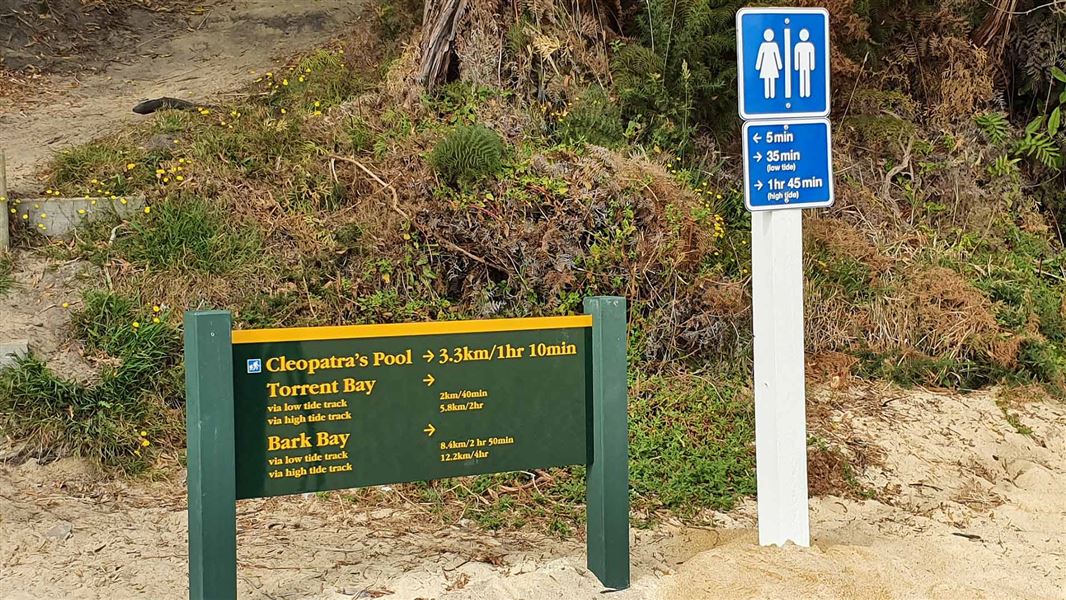Archived content: This media release was accurate on the date of publication.
Date: 31 January 2020
The Abel Tasman initiative is part of DOC’s summer ‘Love this Place’ campaign that informs visitors on how to do the right things in nature, including not littering, using toilets, giving wildlife space, keeping safe in the outdoors and using drones responsibly.
“Pooing outdoors is a growing problem on some popular tracks and it’s not feasible or desirable to try to solve this by putting a toilet on every corner in our great outdoors – influencing behaviour is key to solving this problem!” says DOC Motueka Operations Manager Mark Townsend.
Visitors are encouraged go to the toilet before they start their trip, to plan toilet stops at toilets along the way, and to ‘never say no to a loo when you see one’.
New signage is being trialled on Abel Tasman Coast Track sections where there are longer gaps between toilets. The signs inform visitors of the considerably longer walking time to the next toilet and the short time to the nearest toilet to encourage them to use the nearby toilet before going further.
Most toilets are at coastal hut and camping sites and other bays where water taxis pick up and drop off passengers. The longest stretch between toilets is a 3-hour walk between Torrent Bay and Bark Bay where the track runs inland from the coast.
Mark Townsend says most Abel Tasman visitors are responsible and help care for the park’s environment, including using toilets, but unfortunately some toilet in the bush near tracks and leave behind human waste, toilet paper, and a variety of non-biodegradable sanitary products.
“People come to Abel Tasman National Park to enjoy its beautiful natural environment and we ask visitors to respect and look after the environment by using the toilets provided and not going in the bush.
“There is signage already in the park and at its entrances about toilets but the new signs are an additional reminder to use the nearest toilet while you can.
“Leaving human waste near water risks spread of diseases like giardia into waterways. Weka are also picking up and spreading human poo which increases the risk of it being a health hazard.
“Most people don’t like seeing human waste, toilet paper and other sanitary waste in the bush and our rangers remove it when they see it. Cleaning up biohazards is not straightforward work – strict procedures need to be followed to protect rangers’ health.”
The Abel Tasman National Park and its coast track was chosen for this pilot project because of its high visitor numbers of about 300,000 a year and because toileting in the bush is the main visitor behavioural problem in the park. The campaign is being evaluated to assess whether it influenced visitors’ behaviour.
DOC’s Design and Evaluation Team is monitoring human waste and toileting items at bush toileting hotspots. A preliminary audit before the signs were installed, revealed not only human waste and toilet paper but also numerous other items like wipes, incontinence pads, nappies and other sanitary products.
Additionally, the DOC Design and Evaluation team will be surveying park visitors over summer to ask if they saw the new toilet signs, how well they understood them and whether the signs influenced them to use a toilet.
Additional information
Abel Tasman toilets
The Abel Tasman Coast Track has 66 toilets at park entrances, campsites and huts, and bays where tourist boats drop off and pick up passengers. At the busier hut and camping sites, flush toilets are provided.
Toilets are located at the coast where most visitor activity occurs. These can be easily accessed by boat for cleaning and for removal of sewage from containment tanks. It’s not practical for rangers to walk an hour or two to clean a toilet further inland and it would require the use of helicopters to fly out sewage.
Love this Place campaign
DOC’s Love this Place campaign builds on the success of DOC’s ‘Visit the Kiwi Way’ behaviour in nature campaign that ran last summer (2018/19) and won the Great Journeys of New Zealand Industry Enabler Award in the Tourism Awards.
The campaigns aim to influence visitors to ensure their behaviour has minimal detrimental impacts on the environment, native wildlife and other visitors, and helps them to stay safe in the outdoors.
Contact
For media enquiries contact:
Email: media@doc.govt.nz
